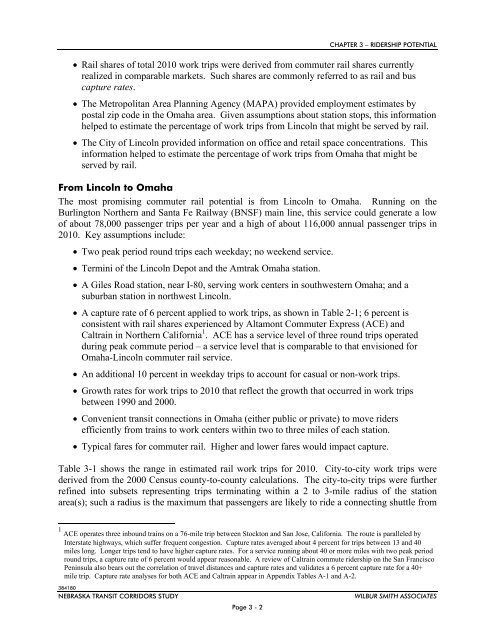NTRAC Final Study - Nebraska Department of Roads - State of ...
NTRAC Final Study - Nebraska Department of Roads - State of ...
NTRAC Final Study - Nebraska Department of Roads - State of ...
Create successful ePaper yourself
Turn your PDF publications into a flip-book with our unique Google optimized e-Paper software.
CHAPTER 3 – RIDERSHIP POTENTIAL<br />
Rail shares <strong>of</strong> total 2010 work trips were derived from commuter rail shares currently<br />
realized in comparable markets. Such shares are commonly referred to as rail and bus<br />
capture rates.<br />
The Metropolitan Area Planning Agency (MAPA) provided employment estimates by<br />
postal zip code in the Omaha area. Given assumptions about station stops, this information<br />
helped to estimate the percentage <strong>of</strong> work trips from Lincoln that might be served by rail.<br />
The City <strong>of</strong> Lincoln provided information on <strong>of</strong>fice and retail space concentrations. This<br />
information helped to estimate the percentage <strong>of</strong> work trips from Omaha that might be<br />
served by rail.<br />
From Lincoln to Omaha<br />
The most promising commuter rail potential is from Lincoln to Omaha. Running on the<br />
Burlington Northern and Santa Fe Railway (BNSF) main line, this service could generate a low<br />
<strong>of</strong> about 78,000 passenger trips per year and a high <strong>of</strong> about 116,000 annual passenger trips in<br />
2010. Key assumptions include:<br />
Two peak period round trips each weekday; no weekend service.<br />
Termini <strong>of</strong> the Lincoln Depot and the Amtrak Omaha station.<br />
A Giles Road station, near I-80, serving work centers in southwestern Omaha; and a<br />
suburban station in northwest Lincoln.<br />
A capture rate <strong>of</strong> 6 percent applied to work trips, as shown in Table 2-1; 6 percent is<br />
consistent with rail shares experienced by Altamont Commuter Express (ACE) and<br />
Caltrain in Northern California 1 . ACE has a service level <strong>of</strong> three round trips operated<br />
during peak commute period – a service level that is comparable to that envisioned for<br />
Omaha-Lincoln commuter rail service.<br />
An additional 10 percent in weekday trips to account for casual or non-work trips.<br />
Growth rates for work trips to 2010 that reflect the growth that occurred in work trips<br />
between 1990 and 2000.<br />
Convenient transit connections in Omaha (either public or private) to move riders<br />
efficiently from trains to work centers within two to three miles <strong>of</strong> each station.<br />
Typical fares for commuter rail. Higher and lower fares would impact capture.<br />
Table 3-1 shows the range in estimated rail work trips for 2010. City-to-city work trips were<br />
derived from the 2000 Census county-to-county calculations. The city-to-city trips were further<br />
refined into subsets representing trips terminating within a 2 to 3-mile radius <strong>of</strong> the station<br />
area(s); such a radius is the maximum that passengers are likely to ride a connecting shuttle from<br />
1 ACE operates three inbound trains on a 76-mile trip between Stockton and San Jose, California. The route is paralleled by<br />
Interstate highways, which suffer frequent congestion. Capture rates averaged about 4 percent for trips between 13 and 40<br />
miles long. Longer trips tend to have higher capture rates. For a service running about 40 or more miles with two peak period<br />
round trips, a capture rate <strong>of</strong> 6 percent would appear reasonable. A review <strong>of</strong> Caltrain commute ridership on the San Francisco<br />
Peninsula also bears out the correlation <strong>of</strong> travel distances and capture rates and validates a 6 percent capture rate for a 40+<br />
mile trip. Capture rate analyses for both ACE and Caltrain appear in Appendix Tables A-1 and A-2.<br />
384180<br />
NEBRASKA TRANSIT CORRIDORS STUDY<br />
Page 3 - 2<br />
WILBUR SMITH ASSOCIATES

















